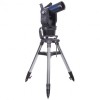Meade ETX-90 User Manual - Page 43
Aligning THE VIEWFINDER
 |
View all Meade ETX-90 manuals
Add to My Manuals
Save this manual to your list of manuals |
Page 43 highlights
bright spots or uneven coatings, giving the appearance of poor quality optics. These effects are only seen when a high intensity light is transmitted through lenses or reflected off the mirrors and can be seen on any high-quality optical system, including giant research telescopes. The optical quality of a telescope cannot be judged by the "flashlight" test; the true test of optical quality can only be conducted through careful star testing. Troubleshooting The following suggestions may be helpful with operation of the ETX90 The power indicator light on the telescope does not come on or there is no response when pressing the AutoStar Arrow keys: • Verify that the Computer Control panel power switch (Pg 14, Fig. 9, 11) is in the ON position. • Verify that the AutoStar coil cord is firmly connected to the HBX port (Pg 14, Fig. 9, 13). • If using internal power (batteries), verify that the batteries are installed correctly and that they have sufficient charge (see Installing the Batteries, page 6). Note: If the batteries are getting low on charge, there will be a marked difference in the slew speed. The speed indicator lights may also flash and the speed may change. If any of these symptoms occurs, turn the power off and replace the batteries. • If using an external power source, verify that it is properly connected between the 9-volt connector (Pg 19) and wall plug (AC source) . • If AutoStar does not respond to commands, move the power switch to OFF and then back to ON. • If the telescope does not slew after power is applied or if the motor quits or stalls, verify that there are no physical obstructions that would impede telescope movement. • If all physical obstacles are removed and the telescope still does not move properly, turn off the power and unplug AutoStar. Plug AutoStar back in and turn the power back on. Unable to see an image through the eyepiece: • Confirm that the lens cover has been removed from the telescope. • Confirm that the flip-mirror control (Pg 14, Fig. 4, 20) is in the "up" position if using the eyepiece holder (Pg 13, Fig. 3, 4) so that light is directed to the eyepiece (Pg 13, Fig. 3). Confirm that the flip-mirror control is in the "down" position if using the #932 Erecting Prism or doing photography with an ETX model. Object appears in the viewfinder but not in the eyepiece: • The viewfinder is not properly aligned with the telescope (see Aligning THE VIEWFINDER, page 8). Slew speed does not change when you change slew speeds or the telescope moves slowly even though the fast slew speed is chosen: • The battery power may be low. Replace all batteries with fresh, new units. Telescope does not track a celestial object: • Make sure that the telescope is correctly aligned. See Easy (Two-Star) Align, page 11, for more information. Images through the eyepiece appear unfocused or distorted: • The magnification may be too high for the viewing conditions. Back off to a lower power eyepiece (see "Eyepiece Calc", page 28) and "Choosing Eyepiece" page 17. • If inside a warm house or building, move outside. Interior air conditions may distort terrestrial or celestial images, making it difficult, if not impossible, to obtain a sharp focus. For optimal viewing, use the telescope outside in the open air instead of observing through an open or closed window or screen. • If viewing a land object on a warm day, heat waves will distort the image (see Terrestrial Observing, page 23). • For clear viewing of objects, turn the focus knob (Pg 13, Fig. 3, 8) slowly since the "in-focus" point of a telescope is precise. Turning the focus knob too quickly may cause the focus point to pass without notice. • The optics within the telescope need time to adjust to the outside ambient temperature to provide the sharpest image. To cool down the optics, set the MAINTENANCE 43















